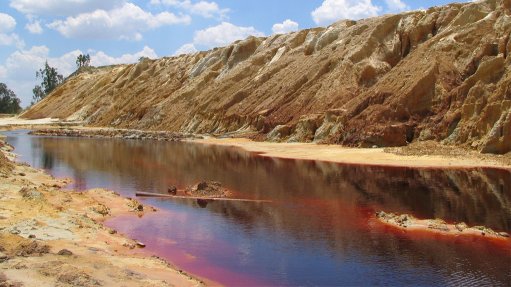
HAZARDOUS The impacts of land contamination can be significant and widespread for mine operations, leading to high costs
Amid a range of land contamination issues in South Africa, mining houses are increasingly adapting their operations to be more holistic to curb environmental risks and create meaningful value for local stakeholders while achieving their objectives.
Engineering consultancy WSP Africa environment and energy MD Sean Doel tells Mining Weekly that land contamination issues from mining operations and mineral processes pose potential environmental and health risks.
The most common land contamination issue locally is associated with groundwater, particularly in Gauteng’s gold mining areas, where significant acid mine drainage (AMD) has caused widespread groundwater contamination. Moreover, at most mining operations, removing material from the ground led to surface-water drainage and runoff water-related issues, which can also result in water contamination.
The impact of land contamination can be significant and widespread for mining houses, leading to high costs. In addition to the environmental risks, there are also economic repercussions; land either becomes unusable or has to be remediated or rehabilitated, which incurs additional costs, Doel says. Other stakeholders, such as government, are also affected, mainly by the costs associated with managing public health risks caused by exposure to contaminated land.
As such, mining houses require assistance to understand land contamination issues, and with assessing, quantifying and managing risk, as well as delivering the best possible outcome for investors, owners, tenants, communities and the environment.
WSP can provide such assistance and services, working with mining houses on a consultative basis and combining its environmental, financial, social and engineering skills to design and implement a site-specific, cost-effective solution for mines and ensure a mining project that is sustainable in the long term.
Doel explains that the company’s designs are long term, taking into account the mine’s requirements and community needs. This entails stipulating the correct controls and protection for the duration of a mine’s operations. These can take the form of, for example, environmental management plans in which environmental risks are articulated and measures to mitigate these risks are set out.
Secondly, WSP assists mining houses to quantify the funds and necessary steps to safely close the mine and associated infrastructure to ensure that the land is usable thereafter, without resulting in any potential risk to communities that will live on the land or the area surrounding the mine.
“Essentially, this allows for gaining double value from a mining project by achieving the mine’s objectives and enabling communities to benefit in the long term. There is an awareness of land contamination in South Africa and a desire to develop world-class projects that leave as small an impact as possible.”
Doel explains this double value in terms of water supply, which is a necessity for mines. WSP designs infrastructure in such a way that water can be supplied to local communities surrounding the mine during its operations, and that water and water-treatment infrastructure can be used by communities post-mine life.
He emphasises the importance of designing a tailored solution that is site specific. For example, when dealing with industrial operations, which usually involve various processing plants, WSP would design site-specific treatment systems to prevent land contamination. Some examples of this are liners and barriers for storage of hazardous products or wastes, or groundwater treatment systems to control off-site movement of contaminants where groundwater impacts have already occurred.
“There is extensive knowledge in the mining sector and among the specialists, consultants and advisers that assist industry. Moreover, as long as pragmatic legislation that balances public health, environmental factors and economic factors continues to be developed, the inherent desire that exists to comply and achieve the most productive mining project outcome, while having a positive relationship with local communities regarding the projects, will lead to positive outcomes,” Doel concludes.